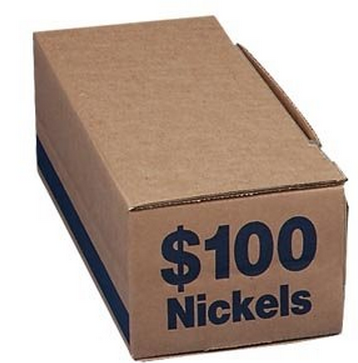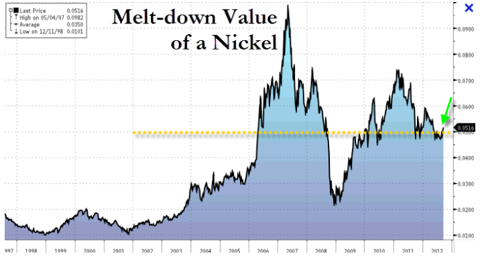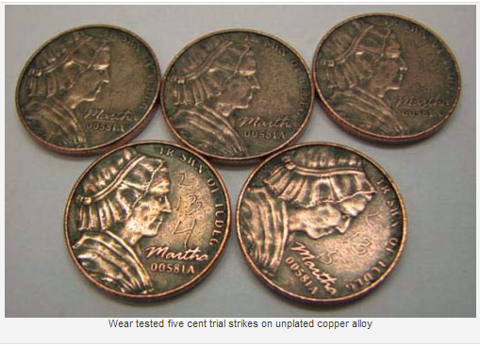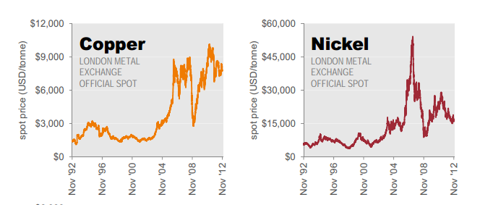"When a government compulsorily overvalues one type of money and undervalues another, the undervalued money will leave the country or disappear from circulation into hoards, while the overvalued money will flood into circulation." - Sir Thomas Gresham (Gresham's Law)
The Jefferson nickel, or the Cupronickel, should be considered as America's last honest currency. Your first reaction might be "only a kook cooped up in bunker would hoard nickels, right?" Not exactly. Consider this: Kyle Bass, founder of the Hayman Capital Partners hedge fund, reportedly exchanged one million dollars for 200 million Cupronickel nickels.
Cupronickels consists of 75% copper and 25% nickel. Coinflation tracks its "melt value," which is currently about 5.2 cents (3 cents copper and 2.2 cents nickel). At this level and with returns on savings nearly zero, a nickel is a open-ended call on both inflationary spikes in these metals and moves by the U.S. Mint to melt down the Cupronickels and reissue a cheaper version, thus putting Gresham's Law into play.
Chart source: Bloomberg
On the the prospect of a new coin, the Coin Modernization, Oversight and Continuity Act of 2010 recommends in its December 2012 report that advanced notice of two to three years be given before all old nickels are removed from circulation and further study proceed. They also note that the current 5-cent coin costs 10.1 cents to produce and distribute. Once the Cupronickel metal composition changes, prices of the coins will jump because sorting will become required. Then Cupronickel investing goes from incredibly cheap to having higher costs, making your initial capital investment in nickels even greater. At that point, a secondary market would kick in, similar to what happened with pre-1964 silver coins. This will be especially true if the underlying metals in the coins appreciate in the current deluge of fiat money printing. Although one might wait for the change in metal composition to occur, realize that the new coinage will enter the banking system quickly and banks may pull the old coins just as fast. Since the banking system is the best vehicle for procuring these Cupronickels, it makes since to be preemptive.
Image sources: Coin Modernization Report
Few investments offer a floor like this, or insurance back-up plan. Obviously, each Cupronickel holds a 5-cent face value, so worst-case scenario you can cash in on your currency for its original value as an exit strategy. At first blush, because of the weight and storage issue, this might seem to be more a working class investment. Perhaps so. Yet, even for well-to-do folks - and and particularly savers - $100 boxes or $2 rolls serve as real emergency money. One full shoe box weighing 110 pounds holds about $500. The $100 bank box pictured below is my preferred method of hoarding Cupronickels.

Many argue that leaving lots of money in so-called insured banks offering no return is the poor option. I have had little problem picking up several $100 boxes at my local bank and have queried about picking up more from others and was told to give them a little advanced notice and they could arrange it. My test sort through about $30 in nickels for older and more valuable coins yielded virtually nothing. Silver content war years nickels have been picked clean.
I've struggled with the idea of keeping gold or silver around because of potential theft. Nickels, however, are a stealth form of metal investment because it is less prone to attracting the attention of thieves. Given that $1,000 worth of nickels weighs 220 pounds, it is hard too imagine that a nickel holder would be a reasonable target. A thief would need a dolly, a moving crew and a good size truck for much of a take.
As an investment, nickel as a component has good prospects, as it is quite depressed and trading at about a third of its 2007 super spike. The simple explanation is that the price spike of 2007 brought out more production. Now, nickel is selling at or below its marginal cost of production, which is about $17,500 to $20,000 a ton across the industry. Vale, the world's second largest nickel producer, has been shutting down older mines, as has Xstatra in Australia. Nickel is primarily used in the production of stainless steel. Additionally, European distributors are maintaining bare-bones inventory, another classic sign of a washed-out resource.
Source: Wall Street Journal



